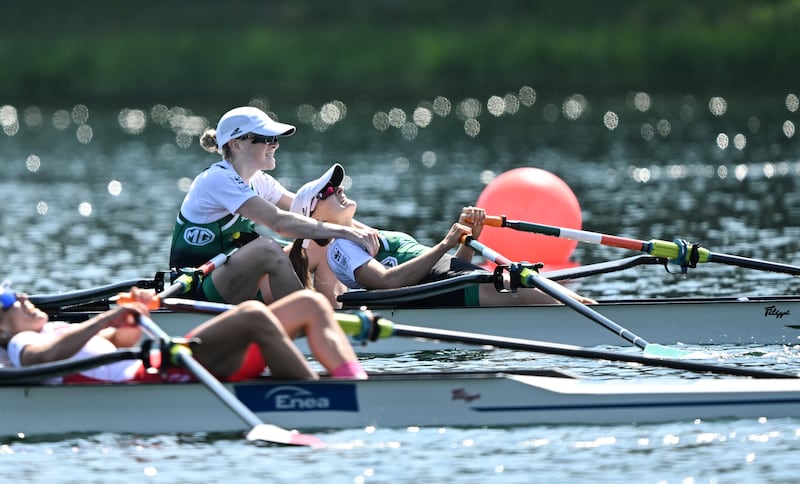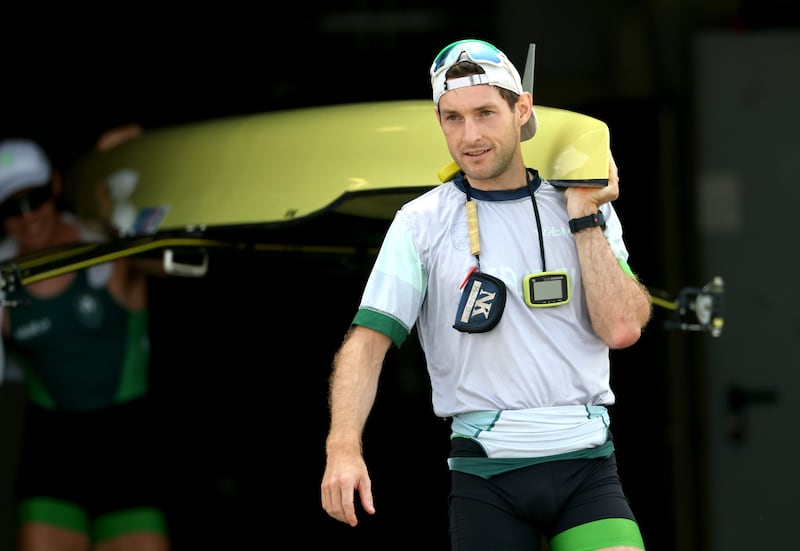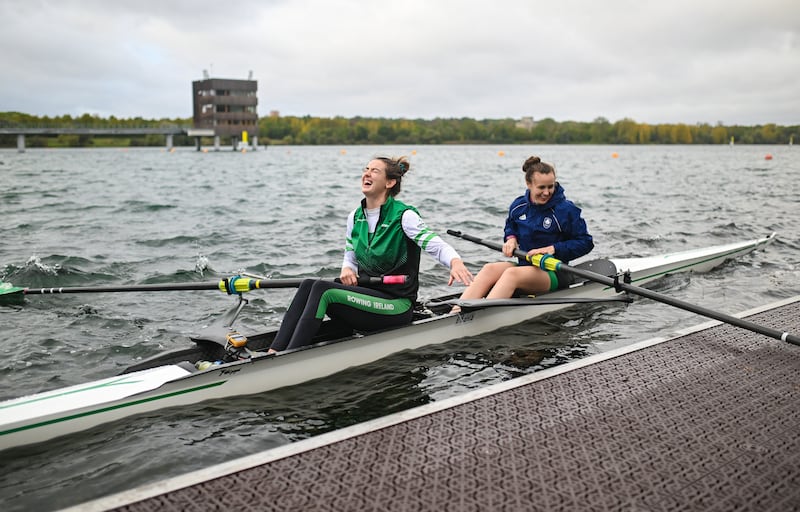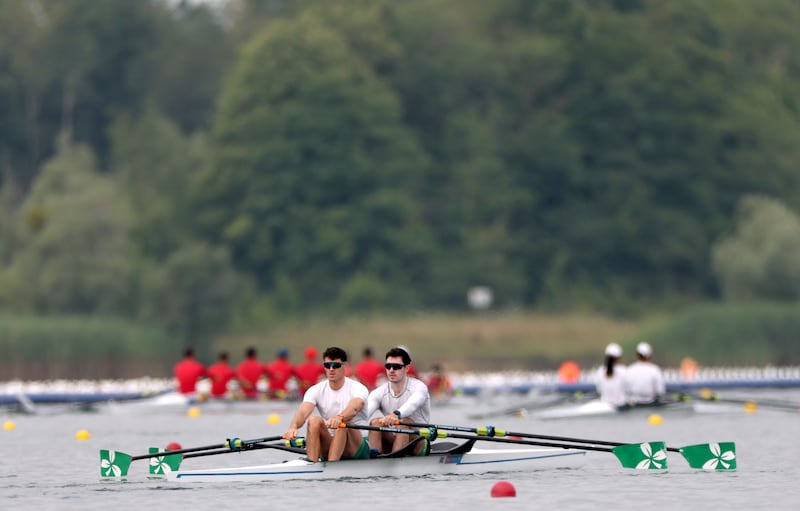Tales from the riverbank.
Mags Cremen and Aoife Casey live together in a bubble. Though it is small, there is room for two. In rowing, crews are selected by trials where the only chemistry that matters is speed; Cremen and Casey were matched in that way too. Their partnership, though, was overlaid with friendship. The boat was not just a hard station for their daily paces, it was another part of them.
Harmony is composed from different sounds. In their boat there is bass and drums. Casey says she is “a bit of a control freak. I’m a bit, I don’t know, high.” Cremen, she says, “is chilled. Her calmness makes the boat go well.”
They look at each other and see something different, exporting and importing in an ongoing trade. “Aoife knows how the boat runs,” says Cremen. “She has good boat feel. I just want to, like, pull hard.”
[ Meet Team Ireland - RowersOpens in new window ]
In the boat’s engine, Cremen is the ignition, Casey handles cruise control. “Mags probably has more fast twitch muscles,” says Casey. “I’m very like, middle of the race, that’s my strength. Mags has such a strong start and such a strong finish. What I might be missing, Mags has loads of.
“We’re on the same page but I know that I must get my shit together. I must go off the start because Mags is going to go and I must back her up. As our rowing has gotten better our friendship has gotten better.”
They first rowed together as juniors in 2017. The Olympic project started three years later. The Tokyo Games were delayed by a year because of the pandemic, and they qualified at the last-chance regatta with only a few weeks to spare. They were both 22, the youngest crew on the Irish team, wide-eyed and wowed.
“We just lapped it up,” says Casey. “The atmosphere in the [athletes’] village, it was honestly like a party. We were just in good form all the time. You’d walk past Tom Daley, the diver, and it was just madness. We had travelled so far across the world, it was like a completely different planet. We learned so much about ourselves.
“I’d say besides us and our families, not many people believed in us, that we were actually going to do it [qualify]. It was almost naivety made us take everything in our stride. We just went with the flow.”
At the Olympic regatta they finished eighth. A year later they won bronze at the world championships. In 2023, they missed out on a place in the world championship final by 0.3 of a second. The United States boat that knocked them out in the semi-final took silver in the final.
Casey and Cremen were sent to the B final where only the winners would qualify for the Olympics. The Olympic champions and silver medallists from Tokyo lined up in the same race. Murder.

“That was huge pressure,” says Cremen. “Even the night before, having to deal with that. ‘What if we don’t qualify tomorrow?’.”
“We did a lot of talking on the night before that B final,” says Casey. “That’s the thing about rowing with one of your best friends, you can talk about anything. I remember going to sleep and I was saying the race plan aloud. ‘And what if this happens? And what if this happens?’ We’re always there for each other. You get to share the highs and lows.”
“And trust as well,” says Cremen. “If we are in a high-pressure situation, we have a lot of trust in each other.”
They made it.
Biggest Ireland team
Cremen and Casey are part of the biggest rowing team that Ireland has ever sent to the Games. In Rio, in 2016, when Paul and Gary O’Donovan became the first Irish rowers to win an Olympic medal, there were just three boats. This time there are seven. Of the 16 athletes, 15 of them have already won a medal at the Olympics or the World Championships or the Europeans; six of them have medals at all three.
Paul O’Donovan is attempting to become the first Irish athlete to win a medal at three Olympic Games. Alongside Fintan McCarthy in the men’s lightweight double scull, they are again gold medal favourites. It wouldn’t be a surprise if two other boats joined them on the medals podium.

It is a virtuous circle: a better high-performance system led to improved outcomes. Better outcomes led to increased funding and a bigger pool of athletes and more full-time coaches. A bigger pool of athletes led to greater competition and better outcomes.
The High Performance Centre, next to Inniscarra Lake, is a teeming place now. In the main concourse, next to the coffee dock, there used to be tables with a panoramic view of the water. Now that space has been colonised by rowing machines, shoved together like dormitory beds.
“When I first came here [nearly 10 years ago] there were six or seven on the team,” says Aifric Keogh, “and probably half of those people were working or in college, so it was a much quieter building. Whereas now, in the mornings, you struggle to get parking. You’re in the changing rooms firing people’s bags out of the way. It’s a totally different building.

“We’re fighting for equipment here. If we’re all on land, is there actually something for everyone to use? It’s a totally different environment and it’s great. You’ll have someone training beside you and they’ll keep you going on the days you don’t really want to do it.”
After Tokyo, Keogh wondered for a year if she still wanted to do it. She had been in the women’s four that won bronze, the first female Irish crew to win an Olympic medal. She was 29 years of age with a host of academic qualifications and some experience of life in the parallel world where the rest of us live.
Trapped in the long, gruelling, relentless, monotonous training blocks, carrying the bland tiredness that rolls from one day into the next, rowing can feel like a place of incarceration. But it is an open prison. Everyone is free to leave. Keogh elected to stay.
“I was probably ready to leave after Tokyo, or so I thought. With the prolonged Tokyo cycle and even whether [not knowing] if it would go ahead of not, I felt it was quite tiring. My boyfriend was living in Dublin at the time. We were kind of separated for two years during Covid. I was ready kinda to join normal life.
“And I did. I left for a year. I also went to college up Dublin, but I kept a foot in the door, and I still hadn’t fully made that decision [to quit]. One day I said to myself, ‘You are answering this question yourself because you haven’t stopped, you are still training.’ And the fact that it was a three-year cycle [for these Olympics] made it a lot easier as well.”
A few months after Tokyo Keogh said they had left the gold medal behind them, or that was how she felt. But that wasn’t why she came back. The crew that won bronze was broken up and Keogh is in a pair now with Fiona Murtagh, another member of the Tokyo four. The desire to keep going has a strained relationship with glory. Day to day, it has no substance.
“I don’t think medals are enough to keep you here,” says Keogh. “Coming into Tokyo, and now coming into Paris, I kind of have these conversations with myself. If someone told you right now, the result – medal or no medal – would you be happy or would you have any regrets? And I think you have to walk away and say, ‘This isn’t about medals.’ It’s about the day-to-day journey of it and actually enjoying it.”
“There is so much training for so little racing,” says Murtagh. “If you don’t enjoy the journey then, for 90 per cent of the time, why are you here?”
Scattered roots
The team has scattered roots. Nathan Timoney played under-age hurling for Fermanagh and has shared a boat with Ross Corrigan since they were in school; Corrigan played Gaelic football. Imogen Magner lived for five years in Barcelona, competing on the junior international tennis circuit. Being a professional tennis player was her original dream. Rowing came by accident. A second thought.
Daire Lynch went to Yale. Unlike other universities in America, the Ivy League colleges don’t have sports scholarship programmes, at least not by that name. “They have, like, 10 spots and they recruit,” says Lynch. “They call it recruit. In your application you still have to hit all the academic requirements – that’s what they’re very big on there. But then, if you’re recruited it’s like a big star beside your application.
“Apart from that, it’s based on how much money your family makes. Rowing – especially in other countries – is a very wealthy sport, so most of my friends were paying full fees. Like, 80 grand a year. I was paying pretty much nothing really. Less than I would pay here.”
The Ivy League colleges send scouts to the junior world championships and that was where Lynch first encountered them. In the end, he had contact with Yale, Princeton and Harvard. “I wouldn’t be one of the typical athletes they would bring over because I’m only 6′1″ and the average height of the team is about 6′ 5″, 6′ 6″. But on the rowing machine I was very good for my size. I was only 75 kilos but I went under six minutes [for 2kms]. That was obviously very good.
“I was training here by myself before I went over and I probably trained too hard for my age. I was training by myself on the rowing machine all the time. I was doing 350kms a week when I was 17. Obviously, that’s how I got quick. When you train that much, you’re bound to get quick.”
For the Tokyo Olympics, Lynch, Philip Doyle and Ronan Byrne were fighting for two seats in the men’s pair. Lynch and Byrne won silver at the European Championships in 2020, but Byrne and Doyle had won bronze at the World Championships a year earlier, qualifying the boat for Tokyo in the process. In the end Lynch was squeezed out. He travelled as a reserve.

“There was me, Gary O’Donovan and Lydia Heaphy. We were the three spares. We literally flew to Tokyo and went to this holding camp – a very nice spa resort kind of place. We were in the Japanese baths all day.”
He had unfinished business.
United by suffering
Wherever they came from, or however they got here, all of them are united by suffering. The training load makes them vulnerable to sickness, constantly. Casey missed the European Championships this year with illness; Cremen went in a single scull and came home sick. Weeks of training were interrupted. “You’re pushing your body every day,” says Casey. “It makes you more susceptible to picking up things.”
Everything is designed for what they must endure in a race. Fintan McCarthy and Paul O’Donovan talk about “riding the red line”.
“Say if you’re in the final,” says O’Donovan, “the fastest way for us is to stay as close as we can to the red line the whole way down.”
“But I guess it’s not really about hitting it,” says McCarthy. “You’re trying to ride it the whole way down and not go too far past it. Because if that happens, you’re dust.”
For all of them the experience is the same. There is no exemption or amnesty.
“The pain would kind of set in a minute after the start [of a race],” says Cremen. “You’re kind of looking at six minutes of pain. But I suppose you get used to being in pain and pacing yourself and just being in the fight. That’s what I would nearly describe our races as – like a fight.”
The worst of the pain is behind them. Now the fight.





















